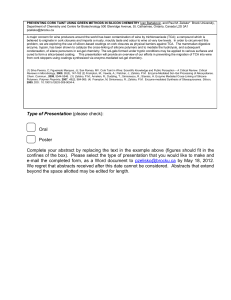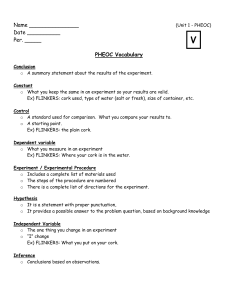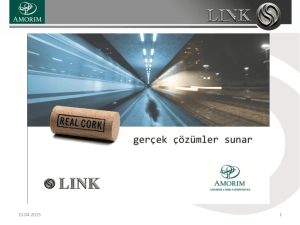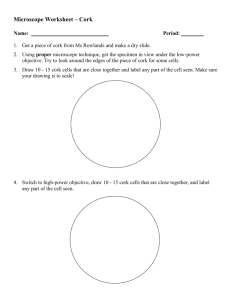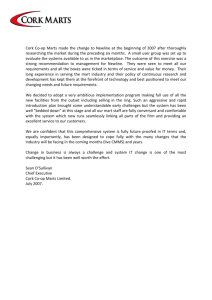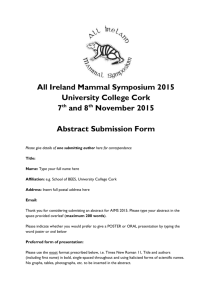Media Kit - Amorim Cork America
advertisement
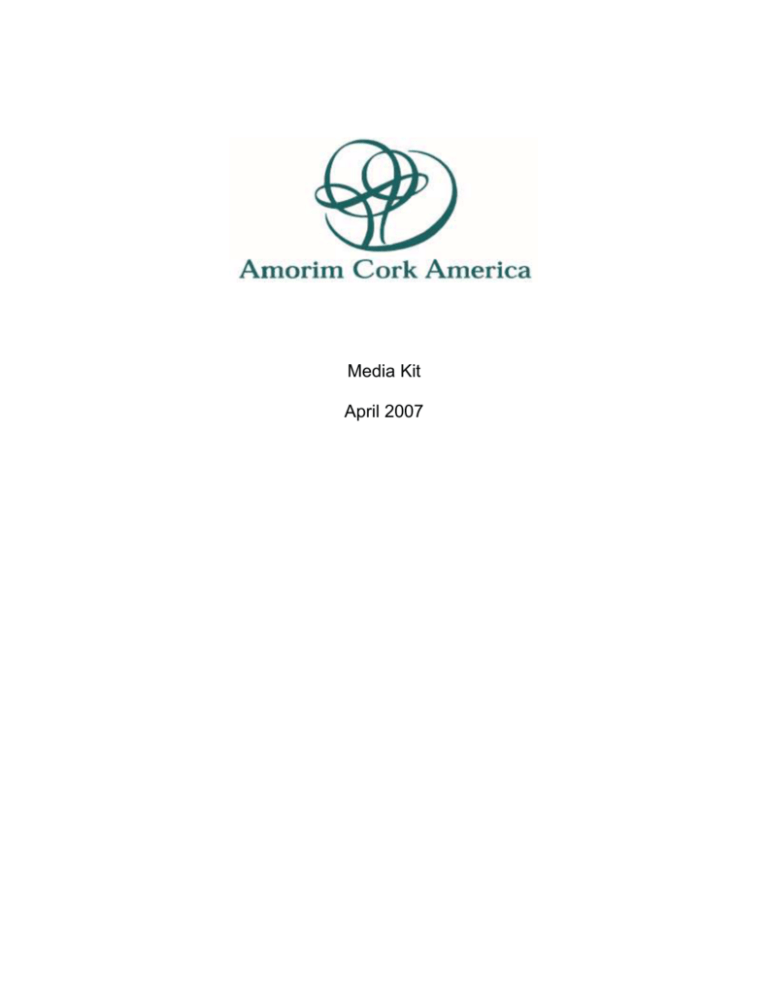
Media Kit April 2007 Table of Contents Amorim Company History Amorim Mission Statement Amorim Chronology Amorim Cork America A Brief History of the Cork Industry Amorim’s New Weapons Against TCA – CONVEX, ENOS II and ROSA How ROSA Works ROSA Fact Sheet Ongoing Research Frequently Asked Questions About Corks TCA Update From Catherine Fallis, Master Sommelier Summary Fact Sheet and Key Contacts Appendix o o Amorim Bios Digital Photo Archive Amorim Cork America Media Kit April 2007 1 Amorim Company History The Amorim Group (Amorim Investimentos E Participações, S.G.P.S., S.A.), with over 140 companies and 6,000 employees worldwide, is one of the largest companies in Portugal. Its vast holdings include real estate, tourism, natural resources, wine and agriculture, technology, insurance, commercial development, communications and cork production. (www.amorim.com) The 135 year-old, fourth generation, family-run business traces its humble beginning to António Amorim in 1870, when he began manufacturing natural cork closures for the Portuguese Port wine market. Today, the manufacturing of cork stoppers is directed by Amorim & Irmãos with manufacturing facilities and sales offices in over 37 countries. With over 3.5 billion corks manufactured each year, Amorim is by far the largest manufacturer of natural cork closures in the world. Amorim Mission Statement The company mission is to maintain market leadership and encourage innovation in all its businesses. It is also dedicated to strengthening the Portuguese economy by taking an active role in developing global opportunities for commerce, while being an active steward of the land. Amorim Chronology 1870: Company founded by António Amorim 1900s: Company experiences rapid expansion in exports 1930: Amorim Group opens first factory under Amorim & Irmãos 1950s: Beginning of vertical acquisitions and diversification of cork products 1960s: New factory for the production of granulated cork and agglomerates 1970s: Period of international expansion 1980s: Strong period of technological growth and product innovation 1990s: Global distribution networks established 2000: Amorim commits to major R&D effort against TCA Today: Amorim leads the fight against TCA with new prevention and curative technologies – CONVEX, INOS II and ROSA Evolution Amorim Cork America Amorim Cork America, a division of Amorim & Irmãos, is headquartered in Napa, California, and provides sales, service and custom finishing services to wineries throughout the United States. Formerly known as Cork Associates, Amorim Cork America was renamed in 2000 to reflect Amorim’s global strength and its commitment to the U.S. market. A distinguishing feature of Amorim Cork America is its sales and management team. Virtually all of the team has hands-on experience or formal training in enology and winery operations. Daryl Eklund, General Manager and a distinguished winemaker with over 25 years of wine industry experience, oversees the day-to-day operations of Amorim Cork America. Amorim Cork America Media Kit April 2007 2 In addition to providing consultative services to winemakers and wine quality control managers, Amorim Cork America provides custom finishing and printing services to the Who’s Who of American winemaking. A Brief History of Cork The potential of cork as a sealing technology was not discovered in Portugal. In Egypt, tombs dating back thousands of years were found to contain amphorae with cork stoppers. And in ancient Greece, the bark of the cork oak was used to make buoys to float fishing nets, sandals and the stoppers for vessels which contained wine and olive oil. The father of sustainable harvesting may have been the Greek philosopher Theophrastus (IV-III century BC), who discovered that once cork was stripped from the tree, a new sheath of better quality bark quickly formed. With the Romans, cork was put to a wider range of uses. The scholar Marcus Terentius Varron (116-27 BC) recommended making beehives out of cork, because of it’s low heat conduction. The use of cork beehives continues in North Africa to this day. While the use of cork as a sealing method has been around for thousands of years, it wasn’t until 1680 that a French monk named Dom Pierre Pérignon discovered the virtue of cork as a method for sealing his new style of wine called champagne. The rest is history. Cork stoppers arrived in Portugal about 1700 and were first used in cylindrical bottles around 1770 in Oporto. Acceptance of cork stoppers grew quickly and by 1797, the Portuguese were exporting over 100,000 cork stoppers a year. The real boom in the Portuguese cork industry began in the last quarter of the 19th century. Between 1890 and 1917 the industry’s workforce more than doubled, and by 1930, the figure had increased fivefold, reaching over 10,000 workmen. This made Portugal the world’s leading cork producer. Today, the total worldwide forest area dedicated to cork production is nearly 6 million acres and is divided among Portugal (2 million acres with 52% of world production), Spain (1.3 million acres with 32% of world production), Italy (600,000 acres with 6% of world production), France (60,000 acres with 1% of world production), Morocco (500,000 acres with 4% of world production), Algeria (1.2 million acres with 2% of world production), and Tunisia (160,000 acres with 3% of world production). Cork used for wine stoppers is from a stately oak tree called Quercus Suber L. It is a vegetable tissue formed from microcells that fit closely together. Cork’s most obvious characteristics are its lightness, stability, resistance to wear, elasticity, thermal insulation, and sealing ability. Cork’s honeycomb structure and the nature of the cellular membranes are responsible for the special characteristics of cork and its extensive range of applications from life vests to acoustical tiles to wine corks. Amorim Cork America Media Kit April 2007 3 Most people don’t realize that cork is a renewable resource and that each tree, after it matures to 25 years old, can be harvested in a sustainable manner once every 9 years. The oldest producing cork tree is in Portugal and dates back to 1820. Every 9 years, the Whistler Tree, as it is known, yields enough cork for 100,000 bottles of wine. In comparison, the average cork tree of today produces a mere 4,000 corks during its harvest cycle. Because cork is a natural, chemically inert substance, which does not degenerate even over lengthy periods of time, it is the perfect solution for bottling wine. Amorim’s New Weapons Against TCA Amorim’s position as the global leader in the manufacturing of natural cork wine closures did not happen by chance. It came about through management vision, financial commitment and a company culture where innovation and quality are highly regarded. The 1980’s and 1990’s were exciting times for Amorim & Irmãos. The decision to control the entire cork manufacturing process from harvest to finished product was a revolutionary step in the cork industry. The decision required the creation of a global distribution network that targeted the most important wine-producing countries, and led the company to institute an aggressive infrastructure rebuilding and quality control program like no other in the industry. Amorim assumed accountability for every step in the cork manufacturing process. An important milestone in Amorim’s new quality focus came in 2000 with the opening of the Ponte-de-Sôr processing facility, a modern new plant east of Lisbon, in the heart of Portugal’s cork forests. Today, Ponte-de-Sôr processes almost half the raw materials sourced in Portugal. The plant is where Amorim’s revolutionary CONVEX boiling system was first put to use in the treatment of cork discs for Twin Top® stoppers. The following year a similar plant was opened in Coruche, very near the Ponte-de-Sôr facility. The Coruche plant is where INOS II®, Amorim’s advanced hydrodynamic cleaning process for cork disks was developed for SPARK® champagne corks. 2003 marked another milestone in quality achievement for Amorim. After nearly 5 years of research and development and over $30 million dollars of investment, Amorim announced a major breakthrough in the war against TCA (2,4,6-trichloroanisole), a major cause of taint in wine. The company called its new process ROSA, after the wife of one of its R&D team members. ROSA is Amorim’s latest and perhaps most important development to date in its antiTCA strategy of prevention and cure. ROSA is being described as an all-important curative step. Amorim Cork America Media Kit April 2007 4 Amorim’s Anti-TCA Strategy: (From the November, 2003 issue of FOCUS, Amorim’s Technical Publication) ANTI-TCA STRATEGY - ROSA THE CURATIVE ELEMENT Prevention Reduce TCA Raw materials • Selection • Storage Cleaning • New boiling system • INOS II Hygiene • Ozone Quality control • Chemical analysis Cure ROSA In the late 1990s, Amorim began a coordinated effort to attack the sources of TCA in corkwood and TCA formation in cork processing. The aim was to sharply reduce the incidence of TCA in wine and ultimately eliminate cork as a cause of musty taints. The strategy adopted by Amorim was to examine and validate its production process and develop a suite of techniques to prevent or avoid TCA and remove or cure the contaminant in Amorim’s cork products. Preventive techniques developed since the strategy was adopted have included: Improved cork harvesting methods and controls Rigorous controls on storage and seasoning of raw corkwood New cork purchasing and selection procedures A completely new boiling system (CONVEX) for washing the cork planks An aggressive washing process (INOS II) for cork discs Ozone to deodorize corks and prevent microbial contamination Comprehensive chemical analysis to identify suspect cork Amorim Cork America Media Kit April 2007 5 These initiatives have resulted in significant progress in the fight against TCA. For example, comprehensive chemical testing of cork bales for TCA has virtually eliminated the sensory rejection of corks supplied to Amorim’s U.S. clients, leading to the absence of TCA claims. Using the five gas-chromatography machines now operating in Amorim’s R&D department, Amorim is able to test nearly 2,500 cork samples a week, detecting TCA at very low concentrations. An analytical capability on this scale has enabled staff to routinely identify and isolate suspect batches of cork at all stages of production, thereby significantly improving Amorim’s quality control procedures. How ROSA Works ROSA is based on controlled steam distillation whereby steam and water under pressure force out volatile trace compounds within the cork cells. Steam has long been known to be effective in the laboratory for removing volatile compounds such as TCA from cork. However, getting the process to work reliably on an industrial scale has, before now, eluded manufacturers. By 2003, the ROSA process had been perfected for cork granules used in the manufacture of technical corks, with the result that ROSA-treated technical corks are mechanically and functionally almost identical to untreated corks – except for having a much lower risk of TCA contamination, 75-92 percent in many cases. Mindful of the need for independent validation of the company’s findings, Amorim commissioned four of the top research laboratories in the world to verify their results. The laboratories included the Australian Wine Research Institute (AWRI), Campden & Chorleywood Food Research Association in the UK, Geisenheim Research Institute in Germany and Excell Laboratories in France. The test results were highly consistent and extremely encouraging. They concluded that ROSA did indeed reduce the levels of TCA by 80%. The ROSA process is currently being applied in commercial production to granules used in Amorim’s technical corks, such as Twin Top® and Neutrocork® products. Application of ROSA to discs and stoppers is also underway. A copy of the ROSA independent laboratory results is available by contacting Amorim Cork America at info@amorimcorkamerica.com. Ask for the ROSA TCA trial results. ROSA Fact Sheet Description ROSA is Amorim’s most important development in the company’s anti-TCA strategy. It was introduced in late 2003 as a curative measure in the battle against TCA taint. Amorim Cork America Media Kit April 2007 6 It is a proprietary cleaning process developed under the direction of Dr. Miguel Cabral, Amorim’s Director of Research and Development. ROSA is based on controlled steam distillation, whereby steam and water under pressure force out volatile trace compounds within the cork cells. Validation Mindful of the need to confirm the efficacy of ROSA to the satisfaction of the wine industry, Amorim has invested significantly in validation trials of the new system. In a series of validation tests conducted by Amorim, an industrial ROSA prototype achieved TCA reductions in cork granules ranging from 75% to 92%. In experiments on cork discs (which are used in Twin Top® corks), ROSA reduced the TCA content in samples by an average of 73%. In addition to its own research, Amorim commissioned independent validations of ROSA by the Australian Wine Research Institute (AWRI), Campden & Chorleywood Food Research Association (CCFRA) in the UK, the Geisenheim Research Institute in Germany and Excell Laboratories in France. The test results from each laboratory were highly consistent and extremely encouraging. They indicated very large reductions (on the order of 70% to 80+ %) in the average level of TCA in the cork material and provided strong evidence that ROSA is an effective industrial treatment for TCA-affected wine corks. For a copy of the independent laboratory results, contact Amorim Cork America at info@amorimcorkamerica.com or call 707.224.6000. Application The ROSA process is currently being applied in commercial production to granules used in Amorim’s technical corks, such as Twin Top® and Neutrocork® products. The application of ROSA to discs, still wine stoppers and champagne and sparkling wine stoppers is also underway. Cost Because ROSA represents such a significant improvement in product quality, the company is doing its best to absorb the cost of the ROSA process within the existing pricing structure. R&D Commitment Under the guidance of Dr. Miguel Cabral, Amorim’s Director of Research and Development, the company has committed over $6 million U.S. dollars a year since 2000 on R&D development with the sole purpose of improving product quality. In addition, two new factories have come online, Ponte de Sôr and Coruche in southern Portugal, to treat and process cork stopper products. Amorim maintains close working relationship with universities and testing laboratories around the world. Some of these include Excell in France, AWRI in Australia, Campden and Chorleywood Amorim Cork America Media Kit April 2007 7 Food Research Association in the UK, the Geisenheim Institute in Germany, and ETS Laboratories and the University of California at Berkeley in California. Scope Amorim is the world’s largest manufacturer of quality cork products for the wine industry. With representative offices in over 30 countries, Amorim serves every major market in the world. Information More information about ROSA and Amorim products can be found online at www.corkfacts.com/us or www.amorimcork.com. You are also welcome to contact Daryl Eklund, General Manager, Amorim Cork America, daryl@amorimcorkamerica.com or call 707.224.6000. Ongoing Research While Amorim is pleased with the success of the ROSA process for Twin Top® and Neutrocork® products, where cork granules are the key ingredient, the Company has yet to achieve the results it wants with natural corks and champagne corks. The critical issue with natural corks is the possibility of a slight distortion in cork shape as the result of the steam distillation process. With champagne corks, there is an issue of specific gravity of the finished corks. Amorim’s Director of Research and Development, Dr. Miguel Cabral, believes his team will have a solution to these problems in 2006. Other Research Projects The company is proceeding on the following research projects during 2005/06: Extension of ROSA system (ROSA “Evolution”) to cork discs and stoppers; Development of new glue for agglomerated corks and for cork discs; Development of new stopper coatings impervious to TCA and other compounds; Creation of new specifications for champagne corks; Development of new washing process for stoppers – to improve efficacy without damaging physical properties of the cork; Analysis of yellow stain and green cork in raw corkwood – to understand impact on sensory properties; Migration of TCA in corkwood piles – to improve selection procedures; Comparative performance of cork stoppers under different storage conditions – in conjunction with the University of Bordeaux in France. Frequently Asked Questions About Corks (Courtesy Amorim Cork Australia) Q: Why use cork as a wine closure? A: Cork is a unique substance and a long-proven closure for wine. No other stopper combines cork's inert nature, impermeability to liquids, flexibility, sealing ability and resilience. Being a natural product, cork is also environmentally friendly, renewable, Amorim Cork America Media Kit April 2007 8 recyclable and biodegradable. Cork manufacturers such as Amorim combine cork's natural qualities with the latest technology to produce an ideal stopper for wine. Q: Are all corks the same? A: No. Wine corks are graded by quality in up to seven categories. The quality depends on the raw material used and the production processes adopted by the manufacturer. There are also different corks for fortified, sparkling and still wines. Q: What are cork manufacturers doing to improve the quality of their product? A: The cork industry and individual producers are striving to achieve the highest standards. Amorim invests about U.S. $ 6 million a year in research & development to help fulfill its quality commitment to the wine trade. The company's top R&D priority is to eliminate 2,4,6-trichloroanisole (TCA) from its wine corks. Q: What guarantee does the winemaker have that the wine will reach the consumer in peak condition? A: Industry standards are set out in the European Cork Federation's Code of Good Manufacturing Practice. The Portuguese Cork Industry Association has adopted a program, Cork 2000, to help individual producers comply with the standards. An independent auditor will assess producers for accreditation under the scheme. Winemakers buying from an accredited producer can be confident in the quality of the cork they purchase. Amorim's high standards set the benchmark for the Code. Q: As a winemaker, does it matter which manufacturer or supplier I buy my wine corks from? A: Yes. As in all manufacturing sectors, each cork producer uses its own methods. At Amorim only tried and tested procedures are employed, and only the most modern equipment and technology are used in processing the cork. Systematic and detailed laboratory tests are conducted throughout production. All the products used in Amorim's manufacturing process meet the most demanding international standards for quality, safety and contact with human food, including those of the Food and Drug Administration in the U.S. Amorim & Irmãos, the largest producer in the Amorim Group, is the only fully integrated cork producer to have achieved ISO 9002 accreditation for all stages of the production process. Q: If I buy good-quality corks from a reputable supplier, will that ensure the corks will always perform as required? A: Amorim's manufacturing procedures ensure the quality of its product on dispatch to the winemaker. However, after receiving the corks, winemakers need to handle them Amorim Cork America Media Kit April 2007 9 carefully to ensure they remain in peak condition. Care also needs to be taken in the transporting of corks to avoid contamination and maintain the correct humidity. Amorim provides guidelines on ordering, storing and handling of corks. Q: What is the incidence of cork taint? A: 'Cork taint' is a misnomer - cork itself does not affect the wine, but the cork may become contaminated with TCA, a worldwide pollution affecting many food and beverage products, and this may migrate into the wine, causing taint. There is no definitive research that accurately determines the incidence of cork-related taint, although oenological studies suggest that 2-5% of wines are affected by some sort of taint, of which cork taint is one factor. Random sensory testing of Amorim corks in 1997 revealed that from a sample of 24,000 corks fewer than half a percentage point (0.48%) were defective. Amorim's goal is to reduce this number to zero. Q: Can wine be affected by TCA only through the cork? A: No. TCA is often referred to as cork taint; this wrongly suggests the cork is the sole cause of TCA. However, TCA can be found in bottled water, wine bottled with screw caps, beer, spirits, soft drinks, packaged food products and even raisins. TCA in wine may be due to: Contaminated oak barrels or corks Contaminated winery machinery or bottling equipment Airborne molds in the winery environs Molds in transport containers or the home cellar Q: Is all wine spoilage caused by TCA? A: No. There are no definitive figures on TCA contamination. TCA is only one type of wine spoilage. Some types of wine spoilage are sometimes wrongly identified as cork taint. Q: Is it true that cork taint is caused by the widespread use of pesticides in the 1950s and 60s? A: Some researchers believe the historical use of pesticides containing compounds such as pentachlorophenol may be contributing to the TCA problem. However, these chemicals have not been used for maintenance of the cork forests for many years. Amorim has purchasing records going back 40 years to help it identify where the best quality cork comes from. Amorim's manufacturing process is designed to thoroughly clean cork of all contaminants. Amorim Cork America Media Kit April 2007 10 Q: How do champagne corks differ from natural cork? A: Champagne corks are made from a single molding of high-quality natural granulated cork, giving it uniform physical and mechanical characteristics. At one end these corks have two or three discs of fine natural cork. Natural corks are punched whole from the best quality cork bark. Q: What is a Twin Top® cork? A: Twin Top® corks are known as technical corks to distinguish them from natural straight corks, which are punched in one piece from the bark. Technical corks are assembled from granulated cork. The Twin Top® cork has discs of fine natural cork at either end and a granulated cork body made from high-grade natural cork left over after cork punching. Q: Is there a world shortage of cork? A: There is enough cork in the cork forests of Portugal to last more than 100 years. The introduction of new products such as Twin Top® corks for commercial wines allows even better utilization of existing cork resources. A reforestation program means that the forests are growing by four per cent a year. Q: Are the cork trees cut down to obtain the material to produce wine corks? A: No. To harvest the cork, the outer bark is stripped from the tree once every nine years and the tree regenerates the bark. The cork industry is environmentally friendly and truly sustainable. Cork trees are only removed when they become decrepit with age or to reduce overcrowding. Q: What is a colmated cork? A: Colmated corks are made from lower-grade natural cork with larger lenticels or structural imperfections. After punching, the corks are coated with a mixture of fine cork particles and natural latex to seal the surface of the cork and improve its performance as a wine stopper. Q: What is a Neutrocork®? A: Neutrocork® is a new generation of technical stopper, and a product of great structural stability. It is suitable for wines intended for early consumption, which already show a certain complexity. Neutrocork® is an excellent alternative to synthetic stoppers and other alternative closures. Amorim Cork America Media Kit April 2007 11 TCA Update Copyright 2005: Catherine Fallis, Master Sommelier Introduction Traditional wine bottle closures, those made of natural bark cork, have since the 1970s taken the fall for faulty, or tainted wine, where 2,4,6 trichloroanisole, TCA for short, leached into the wine inside the bottle, giving it an off-putting musty, wet cardboard-like aroma and flavor. A few years ago, TCA was under the radar of even the most sophisticated labs in the U.S.A., Australia, and France. Recent technological advances that include the ability to micro-measure the compound in parts per trillion, ppt, and to micro-analyze sensory threshold perception levels, have focused an industry facing a down-cycle on acknowledging and identifying that the problem goes beyond the cork and into the winery, and on taking action to prevent potentially compromised product from hitting the marketplace. What is TCA? TCA is a group of chemical compounds known as chloro-anisoles and is naturally occurring in the environment. TCA is commonly known as the leading cause of "corked" wine, so called as natural bark closures infected with TCA were thought to be the primary vehicle of transmission into the wine. At high levels, TCA imparts a musty or moldy character to the wine or, at low levels, simply suppresses the wine's fruit characters. TCA is a naturally occurring compound and is not known to cause any health risk. Normally, a glass of wine has about the same TCA as a glass of orange juice, unless either is tainted. It's all really a matter of personal sensory thresholds, those of recognition and, ultimately, of rejection. Where is TCA Found? TCA is everywhere. It's in the water. It's in the air. TCA is commonly occurring in wood and any wood by-products such as paper. It is in our homes and offices, our hospitals, grocery stores, libraries, factories and wineries. Wine drinkers may have encountered TCA in a recent bottle or glass, while non-wine drinkers—the other 98% of the US population—may have encountered it in cider, bottled water, tap water (any form of chlorinated water), beer, orange juice, olive oil, bananas, peaches, and even in those little pre-peeled carrots so popular today. In the wineries, it may settle in anywhere cork or cork by-products, wood, paper products, or chlorine are used - in the wooden building structures, wooden storage and shipping pallets, wood barrels, insulated tanks, pipes, refrigeration units, floors, walls, cardboard boxes, and building insulation. TCA thrives in the wet environment of natural stone cellars. Walls in wine caves that have had an application of paint or exposure to white washing containing chlorophenoles may harbor TCA. Amorim Cork America Media Kit April 2007 12 Chlorine facilitates TCA development. Its wine and food industry-wide usage, primarily as a sterilizing or sanitizing agent, is a red flag. It spreads from recently mopped floors or equipment onto wooden walls, wooden pallets, onto cardboard boxes as small as egg cartons, and from there inside the cartons. Chlorine is not good to use in any confined environment; it volatilizes quickly into the air or quickly settles into any organic material. Many wineries routinely began using chlorine bleach as a sanitizing agent in the 1960s, as did cork producers. Ironically, cork producers discovered the chlorine connection as one source of TCA in cork more than 15 years ago and have been using a peroxide solution instead ever since. Napa's Beaulieu Vineyards identified the source of its problem in one single humidifier. Chateau Montelena discovered TCA in their historic cellar, equipment, barrels, and wines. Sonoma's Hanzell isolated it to the sanitizing use of chlorine on the floors and drains in the cellar, and spreading through rubber hoses. Gallo of Sonoma’s Healdsburg winery tested positive for TCA, though, unlike the others, they decided not to recall any wine, including some tainted Frei and Rancho Zabaco product, as the company felt the levels were below perceivable thresholds. Alternative Closures Are Not the Answer Almost overnight, we have learned that the problem is global and environmental, not case specific to cork production. Producers unaware of or simply in denial of the pervasiveness of TCA in the winery environment are jumping en masse away from natural bark closures, despite tremendous efforts made by that industry, and as consumer acceptance grows, to agglomerates made of cork particles and resin, to synthetic closures, and to the twist-off screw cap (TOSC), the most popular of which is the Stelvin closure from Pechiney Capsules, a Roll On Pilfer Proof (ROPP) mechanism sometimes referred to as Roll On Tamper Evident (ROTE). RH Phillips Winery recently released wine finished with the Torqued On Pilfer Proof (TOPP), a closure in common use on liquor bottles. Yet wine packaged with a sterile synthetic or a screw cap may still very well be "corked," or tainted with TCA, if the wine was infected in the cellar prior to bottling. Corrective Action Every element of the winery environment is a potential source of TCA contamination. Owners and winemakers should perform a thorough check of the environment. Bring in the experts; isolate the source(s). ETS in St. Helena, California, one of the most advanced wine analysis laboratories in the world and the first and only independent, domestic wine laboratory with ISO 17025 accreditation, uses Gas Chromatography/Mass Spectroscopy to check for TCA in wine, in corks, and in the winery. Create a realistic, targeted plan of action, execute it, and then follow up aggressively with continued QC checks and procedures. As you do with cork suppliers, ask your packaging suppliers, especially those providing cardboard boxes, what TCA prevention measures they are taking. For those using screw caps, if the gasket seal plastic liner under the metal cap is polyethylene, consider Mylar or polyurethane instead. Polyethylene sponges up TCA. Like brettanomyces and volatile acidity, a little bit of TCA goes a long way. Amorim Cork America Media Kit April 2007 13 Conclusion The wine industry is so caught up in the numbers game, and this is no exception. Recognizing that wine is one of the simple pleasures of life, Gordon Burns, Technical Director and President of ETS, says, "Wine is a complex, organic product and it would be incorrect to rate wines simply by comparing TCA levels. More to the point, there's no single, fixed TCA number that determines whether a wine is good or bad." It was only recently that I learned that even a screw cap-finished wine could be "corked," or "screwed," the word the sommelier community is rapidly minting. Centuries ago, sommeliers pre-tasted the wine and food of royalty. Out of this came the tradition of sommeliers pre-tasting wine in restaurants, checking for faults. With the advent of the screw cap in the dining room, many sommeliers, myself included, thought perhaps we would have one less task to perform. Think again. We, as an industry, have come so far, but, in the scheme of things, have taken only one step on a walk to the sun. San Francisco resident Catherine Fallis, the world's fifth female Master Sommelier, is Founder and President of Planet GrapeLLC, creator of the grape goddess guides to good living programs available now as e-learning, guide books, and live seminars. Visit www.planetgrape.com for more information. Summary Fact Sheet and Key Contacts Amorim USA: Amorim Cork America 2557 Napa Valley Corporate Drive, Suite A Napa, California, 94558 Phone: 707.224.6000 Fax: 707.224.7616 info@amorimcorkamerica.com Contact: Daryl Eklund, General Manager E-mail: daryl@amorimcorkamerica.com Amorim Portugal: Amorim Irmãos Lugar Do Salgueiro – Apartado 1 4536-904 Santa Maria de Lamas Portugal Phone: [351] 22 747 5500 Fax: [351] 22 747 5501 E-mail: marketing.ai@amorim.com Media contact: Carlos de Jesus, Director of Marketing Communications E-mail: carlos.dejesus.ai@amorim.com PR Agency: Balzac Communications & Marketing 1200 Jefferson Street Napa, California 94559 Amorim Cork America Media Kit April 2007 14 Phone: 707.255.7667 Fax: 707.255.1119 Web: www.balzac.com PR Contact: Roger Archey, Sr. Account Executive rarchey@balzac.com Web links: Amorim Website: www.corkfacts.com Amorim USA link to Corporate: www.amorimcorkamerica.com Amorim USA link to Corporate: www.amorimcork.com Cork Quality Council: www.corkqc.com ETS Laboratories: www.etslabs.com Geisenheim Research Institute: www.forschungsanstaltgeisenheim.de Australian Wine Institute: www.awri.com.au Technical Presentation: For a transcript of Dr. Miguel Cabral’s July 2004 presentation on his R&D efforts to develop ROSA, contact Amorim USA, info@amorimcorkamerica.com or call 707.224.6000. Ask for the ROSA transcription. Appendix: Bios of Amorim Team António Amorim, Chairman, Corticeira Amorim António Amorim, Chairman, Corticeira Amorim, the holding company for the cork business of the Amorim Group, represents the fourth generation of the Amorim family at the helm of this international conglomerate. After serving a successful tenure from 1995 to 2001 as Managing Director of Amorim & Irmãos, the natural cork unit of Corticeira Amorim, Mr. Amorim was elected Chairman in early 2001. Mr. Amorim has held a variety of management positions within Amorim-Investimentos e Participações, SGPS since completing his education and joining the family company in 1989. Prior to his role as Managing Director for Amorim’s Corkstopper Division, Mr. Amorim represented the Amoirm Group as an Associate of the Brussels-based European Round Table of Industrialists from 1991 to 1995. Mr. Amorim has also served as Operations Manger for three Amorim Group companies within the real estate sector. Mr. Amorim earned a degree in commerce and social sciences from the University of Birmingham (UK), and he completed the executive program in business administration at Columbia University Graduate School of Business. He also has a diploma in oenology from the University of Bordeaux. Amorim Cork America Media Kit April 2007 15 Daryl Eklund, General Manager, Amorim Cork America Daryl Eklund brings over a quarter century of wine industry experience to Amorim as General Manager of Amorim Cork America’s sales office and state-of-the-art finishing facility in Napa, California. Mr. Eklund joined Amorim in 1994 and assumed the role of general manager in 2001. A winemaker by trade, Mr. Eklund was previously the winery and vineyard manager for St. Andrews Winery before joining Amorim. He has held Winemaker roles at Stag’s Leap Winery and Conn Creek Winery, as well as the Assistant Winemaker title at Trefethen Vineyards. Upon earning a Bachelor of Science degree in Fermentation Science from the University of California, Davis, Mr. Eklund completed an internship with United Distillers and Vintners in the mid-1970s. Nearly 20 years later, Mr. Eklund produced several vintages of his own “Eklund” label of Pinot Noir. Miguel Cabral, PhD, Director of R&D, Amorim & Irmãos Miguel Cabral joined Amorim & Irmãos in 1999 to lead Amorim’s commitment to research and development as the company’s first Director of R&D. Dr. Cabral leads a team of researchers, manages the Amorim laboratory, and coordinates the research finding of an international team of leading scientists around the world, as part of Amorim’s annual $6 million commitment to R&D. Prior to joining Amorim, Dr. Cabral served as Director of the Laboratory of Quality Control for the Vinhos Verdes Official Control Institute beginning in 1995. Dr. Cabral began his career in academia in 1984, first as an assistant lecturer in microbiology and parasitology with the Pharmacy faculty, and then as a professor in Parasitology, at the University of Porto (Portugal), where he still teaches today. Dr. Cabral earned a degree in pharmacy from the University of Porto in 1984, and then completed his PhD in Immunology at the University of Strathclyde (UK) in 1994. Dr. Cabral’s research has been published in three parasitology academic publications and nine microbiology scientific publications. He has also presented his work at numerous scientific conferences in microbiology and oenology. Carlos de Jesus, Director of Marketing Communications, Amorim & Irmãos Carlos de Jesus heads the marketing and communications departments for Amorim & Irmãos and its publicly listed holding company, Corticeira Amorim SGPS. Prior to joining Amorim in 2003, Mr. de Jesus was a partner at Breakstone & Ruth LLP, a leading New York-based investor and shareholder relations firm. Digital Photo Archive A collection of Amorim cork images is available as a PDF file by contacting Roger Archey, Balzac Communications & Marketing, rarchey@balzac.com or 707.255.7667. Amorim Cork America Media Kit April 2007 16
